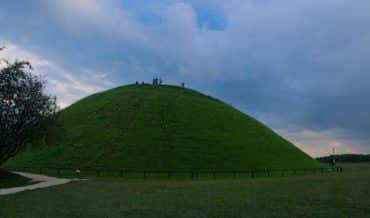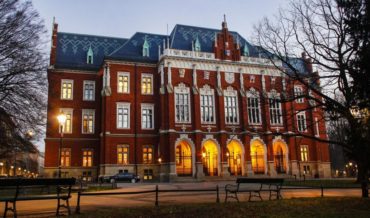Contents
- 1 Key Facts
- 2 Early Life and Military Career
- 3 Academic Transformation and French Studies
- 4 Groundbreaking Academic Contributions
- 5 Civic Leadership and Engineering Projects
- 6 The November Uprising: Sacrifice for Independence
- 7 Academic Martyrdom and Persecution
- 8 Historical Legacy and Commemoration
- 9 Significance in Polish History
Key Facts
- Military hero decorated with the Golden Cross of Virtuti Militari for distinguished service in Napoleonic campaigns (1809-1813)
- Pioneer mathematician who introduced descriptive geometry to the Jagiellonian University as Poland's first professor in this field (1816)
- Co-architect of the iconic Kościuszko Mound in Kraków, applying mathematical principles to monumental construction
- Political representative who defended university interests in the Republic of Kraków's House of Representatives
- November Uprising commander who led student battalions and organized military logistics during the 1830-1831 insurrection
- Academic martyr arrested by Austrian authorities in 1831 and permanently banned from scientific work for patriotic activities
- Internationally acclaimed scholar awarded a diamond ring by the Russian Emperor for his groundbreaking dissertation on stereometry
Early Life and Military Career
Franciszek Sapalski was born in Warsaw during the late 18th century, a period marked by Poland's political upheaval and the partitions that divided the country among Prussia, Austria, and Russia. Rather than pursuing immediate academic studies after completing his secondary education, Sapalski chose military service—a decision that would fundamentally shape his character and later contributions to Polish mathematics and society.
Distinguished Service in Napoleonic Wars
Sapalski's military career commenced during the Napoleonic campaigns, where European powers fought to reshape the continental political landscape. His service record demonstrates exceptional courage and tactical acumen across multiple theaters of war:
1809 Austrian Campaign: During the War of the Fifth Coalition, Sapalski served with Polish forces allied with Napoleon against the Austrian Empire. This campaign was crucial for Polish hopes of regaining independence, as Napoleon had established the Duchy of Warsaw as a semi-autonomous Polish state.
1812-1813 Russian and German Campaigns: Sapalski participated in Napoleon's ill-fated invasion of Russia and the subsequent retreat, followed by the German campaigns of 1813. These operations tested the limits of military endurance and strategic thinking.
Military Recognition and Advancement
Despite being wounded in action during these campaigns, Sapalski continued serving with unwavering dedication. His battlefield valor earned him the Golden Cross of Virtuti Militari, Poland's most prestigious military decoration, established by King Stanisław August Poniatowski in 1792. This honor placed him among an elite group of Polish independence leaders who would continue the struggle for national freedom across generations.
Sapalski's military career progression reflected his leadership capabilities:
- Artillery Captain: His initial officer commission, requiring technical expertise in ballistics and siege warfare
- Major: His final rank, achieved through demonstrated competence in command and military engineering
Academic Transformation and French Studies
Following Napoleon's defeat and the Congress of Vienna (1815), which established the Congress Kingdom of Poland under Russian rule, Sapalski recognized that Poland's future depended on intellectual and cultural development. He made the pivotal decision to travel to France, then Europe's mathematical center, where institutions like the École Polytechnique were revolutionizing engineering and mathematical education.
Advanced Mathematical Training
In France, Sapalski studied under leading mathematicians who were developing descriptive geometry—a discipline created by Gaspard Monge during the French Revolution. This field involved representing three-dimensional objects in two dimensions using systematic projection methods, essential for architectural design, engineering, and military fortifications.
Return and Academic Appointment
In 1816, Sapalski returned to Poland and accepted a revolutionary appointment at the Kraków Academy (now the Jagiellonian University), one of Europe's oldest universities, founded in 1364. As Poland's first professor of descriptive geometry, he introduced cutting-edge mathematical methods that would modernize Polish technical education.
Groundbreaking Academic Contributions
Curriculum Innovation
Sapalski's appointment represented a fundamental shift in Polish mathematical education. His teaching portfolio encompassed:
Descriptive Geometry: The systematic method of representing three-dimensional objects through two-dimensional projections, essential for architecture, engineering, and military applications.
Pure Mathematics: Advanced theoretical mathematics, including analytical geometry and calculus applications.
Astronomy: Celestial mechanics and mathematical astronomy, reflecting the period's integration of mathematics with natural philosophy.
His rapid promotion to full professor in 1817 demonstrated both his exceptional qualifications and the immediate impact of his pedagogical innovations on the university community. His contributions significantly advanced technical education in Kraków, establishing methodologies that would influence generations of students.
Scholarly Recognition
Sapalski's doctoral dissertation, "On the theory of stereometry, ie geometry and plotted," represented a significant contribution to mathematical literature. The work's exceptional quality earned him international recognition, including a diamond ring presented by the Emperor of All Russia and King of Poland. This unprecedented honor demonstrated that mathematical excellence could transcend political divisions, as even foreign rulers acknowledged his scholarly achievements.
Civic Leadership and Engineering Projects
The Kościuszko Mound: Mathematical Monument
Sapalski's most visible contribution to Kraków's landscape was his role as co-architect of the Kościuszko Mound construction project. This massive earthwork, built between 1820-1823 to honor General Tadeusz Kościuszko, required sophisticated engineering calculations:
- Structural stability: Ensuring the 34-meter artificial hill could withstand weather and time
- Geometric precision: Creating aesthetically pleasing proportions using mathematical ratios
- Logistical coordination: Organizing thousands of volunteers and materials transport
The mound's enduring presence demonstrates Sapalski's ability to apply theoretical mathematics to monumental civic projects, and it remains one of Kraków's monuments that best exemplify the fusion of mathematical precision with patriotic sentiment.
Political Representation
During the Free City of Kraków period (1815-1846), when the city maintained semi-autonomous status under Austrian, Prussian, and Russian protection, Sapalski served as a university representative in the Republic of Kraków's House of Representatives. This role required defending academic freedom and institutional autonomy while navigating complex international political pressures.
The November Uprising: Sacrifice for Independence
Revolutionary Leadership
When the November Uprising erupted in Warsaw on November 29, 1830, spreading throughout Polish territories, Sapalski immediately committed his expertise to the independence cause. His dual background in military service and academic administration made him uniquely valuable:
Head of Kraków City Guard: Responsible for maintaining civil order while coordinating with revolutionary authorities.
Student Battalion Commander: Leading university students who had abandoned studies to fight for independence, requiring both military knowledge and understanding of academic culture.
Military Training Coordinator: Teaching drill, tactics, and weapon handling to civilian volunteers lacking military experience.
Logistical Excellence
Sapalski's contributions extended far beyond direct military command, encompassing the complex logistics essential for sustained resistance:
- Weapons Procurement: Organizing purchases and distribution of arms through networks of sympathetic merchants and foreign supporters
- Medical Supply Coordination: Establishing systems for treating wounded insurgents and maintaining fighter health
- Financial Support: Managing funds for combatant families and war orphans
- Intelligence Networks: Coordinating information gathering and communication between resistance cells
Academic Martyrdom and Persecution
The Price of Patriotism
The November Uprising's failure in 1831 brought severe repercussions for all participants. Austrian authorities, who assumed direct control over Kraków, systematically pursued and punished uprising supporters. These actions were part of the broader pattern of Kraków's political upheavals during the 19th century. Sapalski's prominent role made him a primary target for repression.
His arrest in 1831 marked the tragic end of a brilliant academic career. The consequences were comprehensive and devastating:
- Immediate dismissal from the Jagiellonian University faculty
- Permanent prohibition from engaging in any scientific or educational activities
- Social isolation through exclusion from intellectual and professional communities
- Economic hardship due to loss of income and professional opportunities
Intellectual Exile
Despite persecution, Sapalski remained in Kraków until his death, choosing to endure hardship in his adopted city rather than seek opportunities elsewhere. He continued to reside in Kraków's Old Town, where the academic and intellectual community he had helped shape provided whatever support they could offer. His final years represent one of the 19th century's most poignant examples of intellectual suppression for political reasons.
Historical Legacy and Commemoration
Lasting Impact
Franciszek Sapalski's life exemplifies the integration of intellectual excellence with patriotic dedication that characterized Poland's golden age of Romantic nationalism. His contributions span multiple domains:
Mathematical Education: As Poland's first descriptive geometry professor, he modernized technical education and influenced generations of engineers and architects.
Civic Architecture: The Kościuszko Mound remains one of Kraków's most recognizable landmarks, testament to his engineering expertise applied to commemorative purposes.
Academic Freedom: His sacrifice for Polish independence established him as a martyr for the principle that intellectuals have responsibilities beyond their specialized fields.
Memorial Recognition
Sapalski's multifaceted legacy is commemorated by his epitaph in St. Anne's Church in Kraków, where university professors traditionally worship. This memorial acknowledges his roles as soldier, scholar, and patriot—a combination that defined the Polish intellectual tradition during the partitions era. His story has become an integral part of Kraków's historical heritage, preserved for future generations to understand the sacrifices made for Polish independence.
Significance in Polish History
Franciszek Sapalski represents the archetypal Polish intellectual of the Romantic period: a figure who seamlessly combined academic achievement with military valor and patriotic commitment. His biography illustrates several crucial aspects of 19th-century Polish experience:
Education as Resistance: By introducing advanced mathematical methods, Sapalski contributed to Polish intellectual independence even under foreign political control.
International Scholarship: His recognition by foreign rulers demonstrates that Polish intellectual achievements commanded respect across political boundaries.
Sacrifice for Principle: His willingness to abandon a distinguished academic career for national independence exemplifies the Polish intelligentsia's commitment to collective freedom over individual security.
The integration of mathematical precision with patriotic passion in Sapalski's career reflects the broader Polish Romantic belief that technical progress and national liberation were complementary rather than competing goals. His connection to the royal heritage of the city, symbolized by landmarks such as Wawel Castle, demonstrates how intellectual achievement and national identity were intertwined in the Polish consciousness of his era. His legacy continues to inspire scholars who understand that intellectual work carries moral responsibilities extending beyond academic boundaries.


